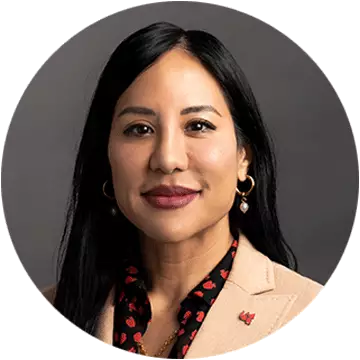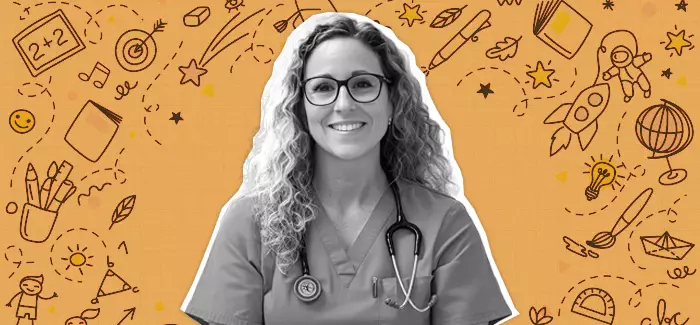What are school nurses?

Written by Morganne Skinner

This article was reviewed by Raelene Brooks, Dean, College of Nursing.

You probably remember the days of going to the school nurse’s office to rest when you had a stomachache. (Or didn’t want to take a test!) Or getting called in to have your hair screened for lice when there was an outbreak. While these memories offer a glimpse of what school nurses do, their care and expertise go beyond tummy aches. Nurses on school campuses may also be called to manage complex care for students with specific medical needs. Let’s dive into what exactly school nursing is, what these nurses do and what it takes to become one. Â
The importance of school nurses
Children with chronic illnesses have medical needs that may require attention throughout the day, and school nurses are responsible for meeting and advocating for them as needed. They communicate the medical needs to other staff members, administrators and support staff, providing clear, digestible information and detailed expectations of what type of care is involved.
In addition, they manage a wide range of tasks, such as wound care, medication administration, wheelchair assistance, inhaler use, ice pack application, health screenings and emergency medical care.Â
Every child’s healthcare experience is different and is often determined by factors outside of their control. They may not all go to see a doctor routinely, but the nurse at school can be instrumental in catching warning signs of disease to help children receive timely diagnosis and treatment. Depending on the program, experience and additional education, school nurses may have learned to recognize symptoms of mental health conditions, developmental delays and potential signs of abuse. For some students, these nurses may be the only healthcare professionals they see, making their role even more crucial in safeguarding children’s health and safety.Â
Well-being and academic performance
According to the National Association of School Nurses, schools with full-time nurses experience higher graduation rates and reduced absenteeism. About 25% of students have a chronic health condition like asthma, diabetes or epilepsy, and 23% of students have a mental or behavioral health condition – all of which can affect their learning and development. It logically follows that students can perform better academically when their health conditions are managed effectively. Nurses at school can help to make this happen.Â
The history of school nursing
School nursing began in the 1900s in New York City as a public health measure to promote hygiene and prevent illness. In response to high levels of truancy, a nurse named Lina Rogers was assigned to work with a physician to screen students at four schools. They sent home the contagious children but treated those who were not contagious before returning them to class. After one month, school absenteeism rates were cut in half. From this point, schools and districts began hiring nurses to work in the schools.
Key historical milestones in school nursing include:
- 1940s – World War II led to a nursing shortage, making nurses at school responsible for addressing broader health issues and preventive care.
- 1960s – Great Society legislation highlighted how poverty affects health and learning, leading to more funding for high-need students in schools.
- 1970s – Disability laws expanded the nurse’s role at school to include care planning meetings and policy change.
- 2020 – The COVID-19 pandemic expanded the nurse’s role to quarantine management, contact tracing and virtual nursing in remote classrooms.
Today, population health remains at the core of school nursing and is one of the broadest nursing specialties, with nurses responsible for both communities and individuals. Historical events have shaped the evolving nursing role in schools, emphasizing the ongoing need for advocacy, flexibility and complex care in the academic environment. Â
Typical school nursing duties
Registered nurses in schools perform a broad range of tasks, from health screenings to partnering with local community resources. They typically provide direct care to students, coordinate with families, support mental well-being, monitor chronic conditions and advocate for student health and access to care.
Health assessments and screenings
Nurses may screen students for scoliosis, hearing and vision. These screenings can help identify health concerns early.Â
Management of chronic health conditions
Some health conditions require nurses to assist with medication administration or other interventions. Examples are diabetes, asthma, epilepsy, cystic fibrosis, anxiety and allergies. Some of these have time-specific care requirements. For example, a child with diabetes may require the nurse to check their blood glucose before meals and administer insulin injections. A child with asthma may need the nurse to administer medication in the morning and an inhaler before gym class.
Depending on each student’s condition, some students may check in with the nurse every morning or throughout the day so the nurse can monitor them. Â
Emergency care and first aid
When students suffer a playground mishap or get hit with a ball too hard during gym class, the nurse is there to provide first aid. Sometimes it is as simple as assessing the child and providing an ice pack or cleaning a scrape and applying a bandage. Other times it may be more serious, requiring CPR and using an automated external defibrillator (AED).Â
Health education
One important role of some school nurses is to provide health education. Schools vary in who teaches health class. Sometimes the nurse handles it; other times it’s a teacher at the school, Even when nurses aren’t teaching those classes, they can still play a role in educating students about their health. Nurses may, for example, teach students about oral health and hygiene, substance use, smoking prevention, exercise, nutrition and sexually transmitted infection prevention. Â
School nursing is about teamwork and collaboration
An important responsibility within school nursing can be providing health services for children who have special needs as part of their individualized education program (IEP). These plans outline the child’s disability-related needs and the care that they’ll receive at school to support their education and well-being. In these cases, the nurse collaborates with parents, teachers and other healthcare members in IEP meetings to create and review the child’s care plan. The nurse’s education and training support provision of the medically necessary care the child receives, as well as any accommodations necessary to promote their health and education.
School nurses may also partner with community organizations, public health departments, and primary care providers to foster healthy communities for children and families. In some cases, the nurse may maintain close communication with a student’s primary care provider to update them on their condition, clarify orders or care plans and report significant changes. For instance, if a student with asthma begins having frequent exacerbations and asthma attacks at school, the nurse may contact the provider to discuss updating the child’s asthma care plan.Â
Essential skills, traits and qualifications for school nursing
To become a school nurse, at a minimum you’ll need to have an active, unrestricted RN license. While you may be able to work in this role with your RN license only, some employers may prefer a bachelor’s prepared nurse. In fact, the recommends a Bachelor of Science in Nursing (BSN) as the minimal education preparation for this nursing role.
Nurses who have obtained a BSN have further developed their professional knowledge and skills. The BSN curriculum builds on a foundation of biological, physical and social sciences paired with the intellectual, social and cultural aspects of the professional nurse.
If you have your RN license, there are programs that allow you to apply previously earned credits to your BSN program, so you can complete the program more quickly. For those with a bachelor’s degree in a non-nursing field, there are bridge programs where you can take three or four additional nursing-related courses and then proceed through to earn your BSN.Â
Skills and traits needed for school nursing
Nurses working in schools need a broad range of skills and knowledge of conditions that affect children and adolescents. Additionally, nursing in schools requires effective communication to coordinate care with multiple team members, parents and students.
Helpful skills may include:
- Critical thinking
- Adaptability
- Advocacy
- Care coordination
- Problem-solving
- Time management
- Attention to detail (observation of emotional, behavioral and cognitive issues)
When it comes to traits, school nurses should be patient, empathetic, sensitive, friendly and compassionate. It also certainly helps if you like working with and being around children! Remember, these nurses work with children of varying developmental stages, so they’ll need to be adaptable in their communication style while maintaining a light-hearted and approachable demeanor to build trust and rapport.Â
Continued education and professional development
Many states require RNs to complete continued education units to maintain an active nursing license in the U.S. Each state’s board of nursing will dictate the number of credits and type needed (if required), but typically nurses have the freedom to choose topics that align with their interest and specialty. For school nursing, consider courses in immunizations, child development, child emergencies, and pediatric or adolescent mental health.
For professional development, joining a professional nursing organization can provide access to continuing education, training and events. It can also be a great way to network, stay updated on evidence-based practices and explore career opportunities. Additionally, memberships can provide advocacy support and resources for nurses to navigate policy changes and maintain high standards of care.  Â
Are you an RN interested in the role of school nurses?
After learning about school nurses, do you see yourself becoming one? If so, you may be facing the choice to return to school to earn your bachelor’s degree. °®ÎŰ´«Ă˝ offers convenient online nursing programs that allow you to enhance your education in a way that fits your lifestyle.
- RN to BSN program: For those who already hold an RN license, this program allows you to earn a Bachelor of Science in Nursing in as little as 14 months for those who transfer with their Associate Degree in Nursing (ADN) (87 credits).
- RN to BSN (Competency-Based) program: Have an ADN? In this program, you can transfer previously earned credits and complete your BSN in as little as 12 months.
Learn more about the online nursing programs at UOPX.Â

ABOUT THE AUTHOR
Morganne Skinner, BSN, RN, is a fertility educator and writer. She began nursing in the surgical-trauma intensive care unit and earned a critical care nursing certification. She earned her Bachelor of Science in nursing from Liberty University in Virginia. She served as a Peace Corps volunteer in rural Zambia for two years, fueling her passion for women’s and public health. After returning to the U.S., she worked in rehabilitation, public health, and fertility. Morganne excels in health education through her writing and fertility work, contributing to fertility and textbook companies and nursing websites, and creating practice questions for the NCLEX.

ABOUT THE REVIEWER
Dr. Raelene Brooks, dean of the College of Nursing, has been a registered nurse for more than 25 years and practiced extensively in the areas of ICU, trauma and critical care. Her publications include a focus on nursing education, critical care and diversity, equity and inclusion. She is a leader in creating, guiding and launching innovative curriculum.
This article has been vetted by °®ÎŰ´«Ă˝'s editorial advisory committee.Â
Read more about our editorial process.


